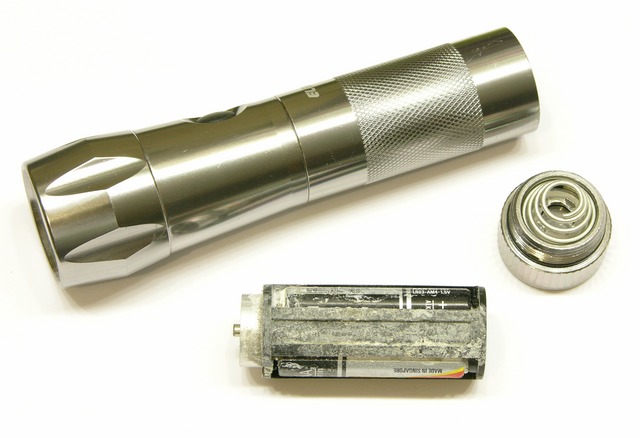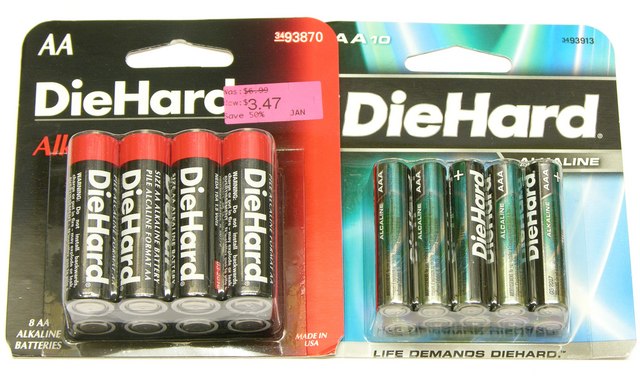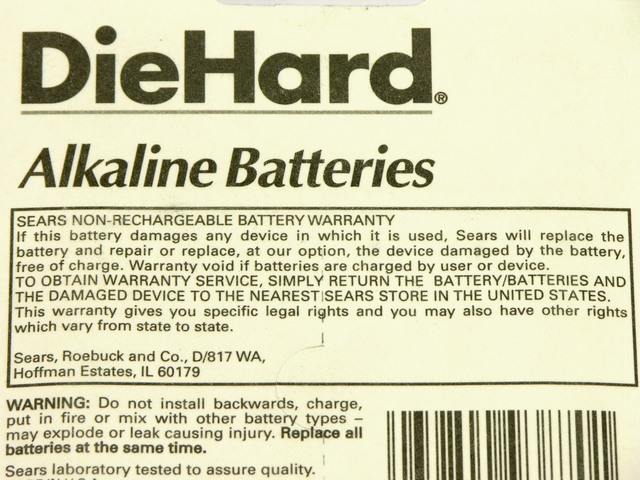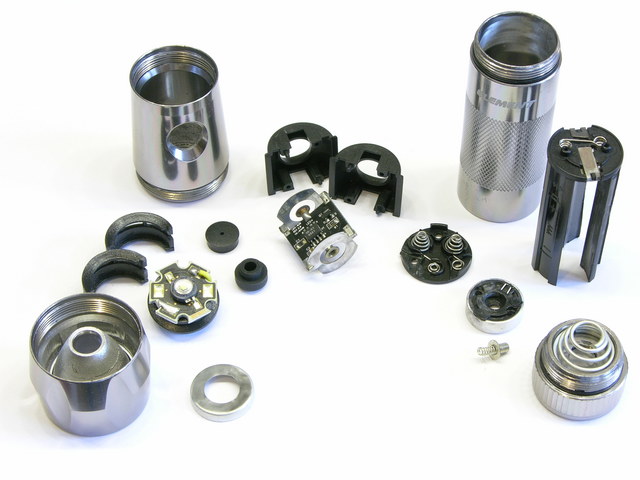I was given this high-quality, hefty, well-balanced, well-performing LED flashlight several years ago with batteries already in it. I keep it in the glovebox; and recently when I needed it, it didn’t power on.
In my decades of using consumer electronics, there’s only one brand of alkaline cells that has never leaked in my equipment — even things I’ve forgotten about and found again years later — and I drive miles out of my way to buy them.
Doubtless someone will pop up with their own horror story, but I’ll still make the claim: You will never, ever, need this.
Cleaning the Flashlight
In order to get out the crud, I disassembled the flashlight completely and cleaned it with a wire brush, a wire wheel on the Dremel, a wire brush on the Dremel, and a toothbrush and dishwashing detergent. I went a little overboard to make sure I had got it all, but at every stage I was getting out more crud.
I’ve long been impressed with the heft and solidity of the flashlight; now that I’ve seen the inside, I’m equally impressed with its design and with the ease of (dis)assembly.
Loosely clockwise from the left, the reflector isn’t adjustable for beam focus but screws off anyway. The heatsinked LED has a separate plastic housing with beveled forward edge that centers the LED against the back side of its reflector cone. The LED housing’s retaining ring doubles as one of the LED terminals.
The aluminum head holds the LED housing and the separate LED driver housing, dropped in from the tail end, and screws tightly to the reflector. The plastic housing for the tiny power switch and LED driver board is made of two identical, completely reversible parts, holding in the inner power switch pushbutton on the one side and leaving a window to check board orientation for assembly on the other.
The rubber outer power switch pushbutton installs after the LED driver is dropped into the head and does not seal against the housing, suggesting that the o-rings on the aluminum housing are for a great feel during assembly and battery replacement rather than for water resistance.
The battery cage holds three AAA cells and assembles easily. The stiles are marked with the cell orientation; the filled cage looks a bit like a C cell and drops into the flashlight handle, with the spring-loaded button and the metal ring contacting corresponding surfaces on the bottom of the LED board.
The tail cap doesn’t make electrical contact with the battery’s negative terminal and the flashlight body doesn’t conduct current, as it does on many less expensive flashlights (not that I think I care).
Cleaned, reassembled, and with AAA cells reinstalled, it once again works perfectly. I look forward to many more years of service … and to not having to clean it out again.




Wow, actual active electronics driving the LED. So many of the LED flashlights maybe toss a resistor in, and hey, if you’re battery power goes out as heat, not our problem.
Another alternative to oozing alkaline cells are Sanyo Eneloop NiMH cells. These recharge just like any NiMH, but have a much lower self-discharge rate (Sanyo claims 85% of full charge after one year of storage, 70% after three years). I’ve used them for a few years now, and the do seem to work as advertised. I have a set (4 AAs) in a reading lamp I use most every night; they have to be recharged only a couple times a year.
JP, looking more closely, that may not be an active driver. The pushbutton switch is momentary contact, and this may just be the on-off debouncer/driver rather than an LED driver. This could very well be relying on the internal resistance of AAA cells to limit the current.
I’m intrigued by your NiMH cells. I use NiMH in almost everything around the house, and as you note, the self-discharge rate is the limiting factor for remote controls, flashlights, and probably even wall clocks. I do have a few devices that care about the lower voltage; but for anything else, I think I’ll give your Sanyos a try.
Had no idea about the DieHard types. I simply would have passed them off as el-cheapos if you hadn’t pointed out the warranty. Going to have to hunt these down.